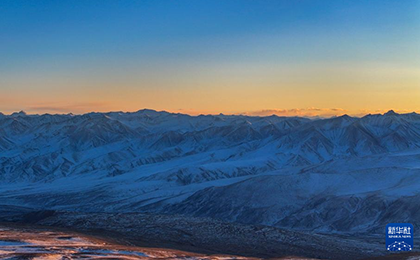



▲The Kunlun Mountains embrace Muztagata Peak under the golden sunset. [Xinhua/Chen Shuo]
2. Focusing on Major Regional Strategies to Create Green Development Hubs.
2.4 Promoting the construction of a green and low-carbon development demonstration belt in the Yangtze River basin.
Efforts will steadily advance coordinated ecological governance among provinces in the Yangtze River Economic Belt and optimize the high-level protection mechanism. A refined unit-based zoning control system will be implemented throughout the Yangtze River basin, systematically promoting the protection and governance of the main and tributary rivers and important lakes. Water ecological assessments will be conducted, and the 10-year fishing ban on the Yangtze River will be strictly enforced. Adhere to the integrated measures for drought and flood prevention, and ensure water quality in the Danjiangkou Reservoir and its upstream areas. Establish a cross-regional ecological compensation mechanism to promote shared responsibility for environmental protection. The Chengdu-Chongqing Economic Circle will promote the coordinated management of cross-border pollution to foster a green, low-carbon, and high-quality living environment.
2.5 Advancing coordinated protection and governance in the upper, middle, and lower reaches of the Yellow River Basin.
Support provinces and regions along the Yellow River to strengthen ecological protection and governance, and accelerate the green and low-carbon transformation of energy and chemical bases along the Yellow River. Implement a rigid water resource management system to improve water efficiency in key industries. Make every effort to fight the ecological landmark battles of the "Three-North" shelterbelt project, including the "Jiziwan" of the Yellow River. Establish coordinated governance mechanisms for the upper, middle, and lower reaches of the Yellow River, focusing on controlling soil erosion and strengthening air pollution joint prevention and control in key areas like the Fenwei Plain. Enhance biodiversity in the Yellow River Delta and implement a comprehensive ecological compensation mechanism for the entire basin to achieve a “costing-sharing, benefit-sharing, and cooperative” framework for ecological protection and governance.
3. Leveraging Regional Strengths to Advance Provincial Contributions to a Beautiful China.
Give full play to the pivotal role of the provinces in building a Beautiful China. In alignment with major regional strategies, each province will systematically plan and implement "Beautiful City" and "Beautiful Countryside" initiatives based on local advantages and distinctive characteristics. The focus will be on excelling in five key areas: (1) promoting green and low-carbon development, (2) achieving fundamental ecological improvements, (3) strengthening ecological protection and restoration, (4) securing ecological safety bottom lines, and (5) deepening ecological civilization system reforms. Adhering to the principle of selective excellence, with strong demonstration and leading power, about five provinces will receive priority support for pilot zone development, each showcasing a unique provincial characteristic.
3.1 Promoting green and low-carbon development.
Strictly enforce the "three red lines" and control the appropriation of territorial land. Ecological zoning management results will be effectively applied, creating exemplary case studies and governance models. A dual-control system for total carbon emissions and intensity will be established. Green and low-carbon technological innovation and applications will be significantly advanced, fostering green manufacturing and service systems. Transport structures will be optimized via accelerated adoption of standardized multimodal transport equipment and new energy vehicles and machinery. Resource conservation and efficiency will be reinforced across all sectors, with key energy-saving initiatives implemented in critical industries. A comprehensive, efficient, and well-regulated waste recycling system will be developed, alongside the nationwide promotion of green mining. Through these efforts, significant achievements in green and low-carbon transformation in key sectors will be attained, positioning these areas at the forefront of national progress.
3.2 Achieving fundamental ecological improvements.
Efforts will focus on addressing environmental challenges and advancing the blue sky, clean water, and clean soil campaigns with higher standards. Fine particulate matter control will be the primary focus, with coordinated multi-pollutant emission reductions, performance-based upgrades for key industries, and urban air quality management initiatives. Implement an intelligent noise map system to build quiet neighborhoods.
Key industrial enterprises will undergo wastewater treatment performance assessments, and pollution discharge monitoring and control systems will be strengthened. Model urban sewage pipeline networks will be built. The "Mother River Restoration Action" will be advanced, with increased regulation of ecological water flows. Take the beautiful river and lake construction index system as a guide to continuously improve the ecological and environmental quality. Encouraging coastal cities in pilot zones to build beautiful bays while exploring innovative governance models for the bays. Efforts will also be made to protect aquatic germplasm resources and restore key habitats. Soil pollution prevention and control measures will be implemented at the source, and a "dual reduction" model targeting historical solid waste stockpiles and new waste generation will be explored, establishing a “Waste-free City”. Major projects will be launched to tackle emerging pollutants. Ultimately, these efforts will result in significant ecological improvements, leading the nation in environmental quality and restoration.
Source:https://www.gov.cn/zhengce/content/202501/content_6998719.htm
Editor & Translator: GUO Xinxin